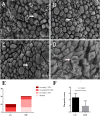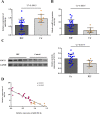Expression and significance of miR-30d-5p and SOCS1 in patients with recurrent implantation failure during implantation window
- PMID: 34496883
- PMCID: PMC8425163
- DOI: 10.1186/s12958-021-00820-2
Expression and significance of miR-30d-5p and SOCS1 in patients with recurrent implantation failure during implantation window
Abstract
Background: Poor endometrial receptivity is a major factor that leads to recurrent implantation failure. However, the traditional method cannot accurately evaluate endometrial receptivity. Various studies have indicated that microRNAs (miRNAs) are involved in multiple processes of embryo implantation, but the role of miRNAs in endometrial receptivity in patients with recurrent implantation failure (RIF) remains elusive. In the present study, we investigated the presence of pinopodes and the roles of miR-30d-5p, suppressor of cytokine signalling 1 (SOCS1) and the leukaemia inhibitory factor (LIF) pathway in women with a history of RIF during the implantation window.
Methods: Endometrial tissue samples were collected between January 2018 to June 2019 from two groups of women who underwent in vitro fertilisation and embryo transfer (IVF-ET) or frozen ET. The RIF group included 20 women who underwent ≥ 3 ETs, including a total of ≥ 4 good-quality embryos, without pregnancy, whereas the control group included 10 women who had given birth at least once in the past year. An endometrial biopsy was performed during the implantation window (LH + 7). The development of pinopodes in the endometrial biopsy samples from all groups was evaluated using scanning electron microscopy (SEM). Quantitative reverse transcription-polymerase chain reaction and western blotting were used to investigate the expression levels of miR-30d-5p, SOCS1, and the LIF pathway.
Results: The presence of developed pinopodes decreased in patients with RIF on LH + 7. The expression level of miR-30d-5p decreased in the endometria during the implantation window of patients with RIF, whereas the mRNA and protein levels of SOCS1 were significantly higher in the RIF group than in the control group. Furthermore, a negative correlation was observed between the expression of miR-30d-5p and SOCS1 (r2 = 0.8362). In addition, a significant decrease in LIF and p-STAT3 expression was observed during the implantation window in patients with RIF.
Conclusions: MiR-30d-5p and SOCS1 may be potential biomarkers for endometrial receptivity. Changes in pinopode development and abnormal expression of miR-30d-5p, SOCS1 and LIF pathway in the endometrium could be the reasons for implantation failure.
Keywords: Embryo transfer; Endometrial receptivity; In vitro fertilization; MiR-30d-5p; Recurrent implantation failure; SOCS1.
© 2021. The Author(s).
Conflict of interest statement
We declare that we have no conflict of interest.
Figures




Similar articles
-
Anti-phospholipid antibody may reduce endometrial receptivity during the window of embryo implantation.J Gynecol Obstet Hum Reprod. 2021 Jun;50(6):101912. doi: 10.1016/j.jogoh.2020.101912. Epub 2020 Sep 17. J Gynecol Obstet Hum Reprod. 2021. PMID: 32950746
-
[Differential expression of microRNA in eutopic endometrium tissue during implantation window for patients with endometriosis related infertility].Zhonghua Fu Chan Ke Za Zhi. 2016 Jun 25;51(6):436-41. doi: 10.3760/cma.j.issn.0529-567X.2016.06.007. Zhonghua Fu Chan Ke Za Zhi. 2016. PMID: 27356479 Chinese.
-
Uterine fluid microRNAs are dysregulated in women with recurrent implantation failure.Hum Reprod. 2022 Apr 1;37(4):734-746. doi: 10.1093/humrep/deac019. Hum Reprod. 2022. PMID: 35147192 Free PMC article.
-
Uterine fluid microRNAs in repeated implantation failure.Clin Chim Acta. 2024 May 15;558:119678. doi: 10.1016/j.cca.2024.119678. Epub 2024 Apr 17. Clin Chim Acta. 2024. PMID: 38641194 Review.
-
The role of microRNAs in the regulation of critical genes and signalling pathways that determine endometrial receptivity.Zygote. 2024 Aug;32(4):261-270. doi: 10.1017/S0967199424000297. Epub 2024 Sep 18. Zygote. 2024. PMID: 39291681 Review.
Cited by
-
MicroRNA signatures in plasma and plasma exosome during window of implantation for implantation failure following in-vitro fertilization and embryo transfer.Reprod Biol Endocrinol. 2021 Dec 7;19(1):180. doi: 10.1186/s12958-021-00855-5. Reprod Biol Endocrinol. 2021. PMID: 34876134 Free PMC article.
-
Acupuncture combined with gonadotropin-releasing hormone agonists improves endometrial receptivity and pregnancy outcome in patients with recurrent implantation failure of in vitro fertilization-embryo transfer.J Assist Reprod Genet. 2024 Aug;41(8):2185-2192. doi: 10.1007/s10815-024-03140-7. Epub 2024 Jun 7. J Assist Reprod Genet. 2024. PMID: 38847932
-
TOP2A deficit-induced abnormal decidualization leads to recurrent implantation failure via the NF-κB signaling pathway.Reprod Biol Endocrinol. 2022 Sep 22;20(1):142. doi: 10.1186/s12958-022-01013-1. Reprod Biol Endocrinol. 2022. PMID: 36138481 Free PMC article.
-
Interleukin-6 as A Useful Predictor of Endometriosis-Associated Infertility: A Systematic Review.Int J Fertil Steril. 2023 Aug 7;17(4):226-230. doi: 10.22074/ijfs.2023.557683.1329. Int J Fertil Steril. 2023. PMID: 37577903 Free PMC article.
-
New insights into Chlamydia pathogenesis: Role of leukemia inhibitory factor.Front Cell Infect Microbiol. 2022 Oct 18;12:1029178. doi: 10.3389/fcimb.2022.1029178. eCollection 2022. Front Cell Infect Microbiol. 2022. PMID: 36329823 Free PMC article. Review.
References
-
- Gerber RS, Fazzari M, Kappy M, Cohen A, Galperin S, Lieman H, Jindal S, Buyuk E. Differential impact of controlled ovarian hyperstimulation on live birth rate in fresh versus frozen embryo transfer cycles: a Society for Assisted Reproductive Technology Clinic Outcome System study. Fertil Steril. 2020;114:1225–1231. doi: 10.1016/j.fertnstert.2020.06.021. - DOI - PubMed
-
- El-Toukhy T, Campo R, Khalaf Y, Tabanelli C, Gianaroli L, Gordts SS, Gordts S, Mestdagh G, Mardesic T, Voboril J, Marchino GL, Benedetto C, Al-Shawaf T, Sabatini L, Seed PT, Gergolet M, Grimbizis G, Harb H, Coomarasamy A. Hysteroscopy in recurrent in-vitro fertilisation failure (TROPHY): a multicentre, randomised controlled trial. Lancet. 2016;387:2614–2621. doi: 10.1016/S0140-6736(16)00258-0. - DOI - PubMed
MeSH terms
Substances
Grants and funding
LinkOut - more resources
Full Text Sources
Medical
Miscellaneous

